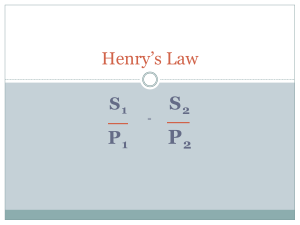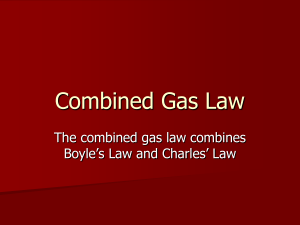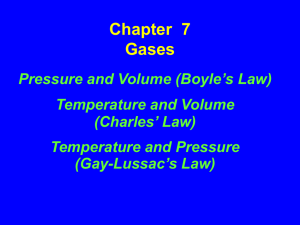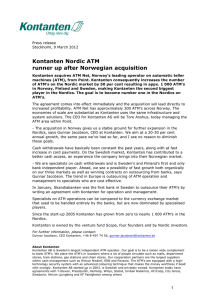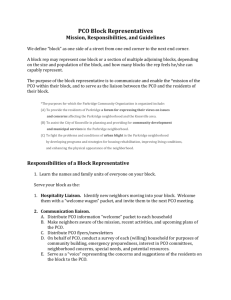LECTURE 6
advertisement
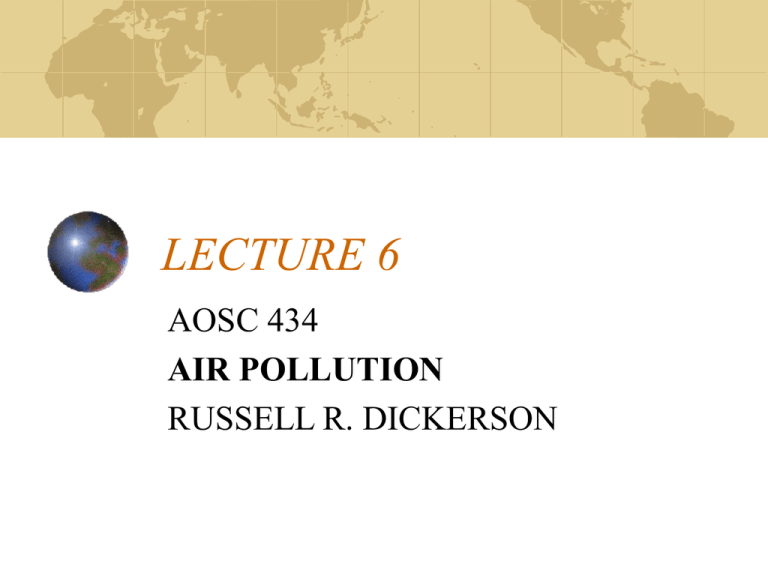
LECTURE 6 AOSC 434 AIR POLLUTION RUSSELL R. DICKERSON THERMODYNAMICS (continued) Wark and Warner Chapter 7,8 Seinfeld & Pandis, Chapter 3 From the last lecture, you will remember the concepts of enthalpy (heat), entropy (disorder) and Gibbs Free Energy (the criterion feasibility). G H T S ΔG RT ln (Keq ) K eq exp( ΔG/RT) How much CO is in equilibrium with CO₂ in auto exhaust? Again, consider the combustion of isooctane (C₈H₁₈) C8H18 12.5O2 ...(47N2 ) 8CO2 9H2O...(47N2 ) The dissociation of CO₂ produces CO: CO2 CO 1 / 2O2 H 0 rxn 283 kJ / m ole G 0 rxn 258 kJ / m ole R 8.31 J / m oleK What is the concentration of CO₂ if there is complete combustion? [CO₂] = 8 / (8 + 9 + 47) = 0.125 If P = 1.00 atm, then P(CO₂) = 0.125 atm. What is the equilibrium constant? 258103 K eq exp(G / RT ) exp 8.31 298 1045 Equilibrium lies far to the left! 10 45 PCO PO2 PCO2 1/ 2 If we assume that all the CO and O₂ come from the dissociation of CO₂ then: [CO₂] >> [CO] = 2[O₂] P = [CO₂]. If total pressure is 1.00 atm then CO 2 PCO ( PO2 ) 0.5 10 PCO 1 ( PCO ) 3 / 2 PCO2 K eq 2 2 PCO2 K eq 2/3 0.125 2 3 1031 atm This is not much to worry about, but combustion does not occur at room temperature, it occurs at about 2000 K. What are ΔG and K eq at 2000 K? Assume that ΔH and ΔS are independent of temperature. We want G2000 K 45 2/3 H 2000 K H 298 K 283 kJ / m ole H 298 G298 S 2000 k S 298 K 298 0.0839kJ / m oleK A positive ΔS for the reaction means that the products are favored by the entropy term in the Gibbs Free Energy, and the equilibrium will be pushed to the right as temperature increases. G2000 283 (2000)(0.0839) 115.2 kJ / m ole K eq 9.8 10 4 PCO 3.1103 atm At P = 1.00 atm [CO] = 0.31% = 3100 ppm It takes only 600 ppm of CO to cause death in humans; see Seinfeld, p.55. The CO is produced quickly and does not reform CO₂ fast enough to be destroyed as the exhaust gases cool. But a car’s engine does not run at 1.00 atm pressure, the typical compression ratio is 8:1 (120 psi). If P = 8 atm and we maintain a stoichiometric air/fuel mixture, PCO2 8[CO2 ] 1.0 atm PCO 2 PCO2 K eq 2/3 1.25x 102 atm This may look like more than we had at 1.0 atm, but at 8.0 atm total pressure: [CO] ≈ 1.6 x 10⁻³ = 1600 ppm Only half as much! Higher compression reduces the amount of CO produced. What happens if we adjust the carburetor to produce a lean burn? Let there be 10% excess oxygen, and leave the total pressure at 8.0 atm. C8 H18 13.75O2 52N 2 8CO2 9 H 2O 52N 2 1.25O2 8 0.114 8 9 1.25 52 8 (0.114) 0.91 atm [CO2 ] PCO2 [O2 ]XS 1.25 0.018 8 9 1.25 52 PO2 0.144atm K eq Rearranging: PCO (PO2 )0.5 PCO 2 P CO K P(CO ) 2 eq PO2 ((0.91)9.8 104 ) /(0.144)0.5 2.6 103 atm m ixing_ ratio 3.3 104 [CO] = 330 ppm This is much less than the 3100 ppm we calculated for a stoichiometric mixture! CONCLUSIONS For minimal CO production: 1. 2. 3. Burn as cool as possible. Burn as lean as possible. Burn as high compression as possible. EXTRA EXAMPLE How much molecular hydrogen will be formed by the decomposition of water in the exhaust gas? This example uses water recombination instead of the water dissociation reaction, whole number coefficients instead of ½, and units of kcal mole⁻¹ instead of kJ mole⁻¹. 2H2 O2 2H2O P (H2O)2 K eq (P (H2 )2 P (O2 )) ΔG0 2(54.63) 109.26kcal mole1 ΔH0 2(57.80) 115.60kcal mole1 P (H2 ) P (H2O)/(P (O2 )Keq )0.5 Assume that the reaction takes place at one atmosphere pressure, 2000 K and slightly lean, 1% excess oxygen. (The concentration of H₂ would be somewhat more for a stoichiometric mixture.) Let P(O₂) ~ 1%, P(H₂O) ~ 10% and T = 298 K, Keq exp(G / RT) 1079 Equilibrium lies far to the right and H₂O is strongly favored over H₂. But at a combustion temperature of 2000 K what happens to ΔG? G2000 H 0 TS 0 (H 0 G 0 ) S T G2000 73 kcal / m ole 0 This difference of 36 kcal (about 30%) makes a large difference in the calculated equilibrium concentration of H₂. K eq 108 PH 2 104 100 ppm In general, for the Gibbs free energy at some temperature other than 298 K. 0 0 H G GT H 0 T 298
